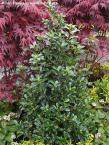Ilex x meserveae (Castle Wall™) 'HECKENSTAR®'

Ilex x meserveae (Castle Wall™) 'HECKENSTAR®'
blue holly, Meserve holly - male
blue holly, Meserve holly - male
| SIZE/TYPE | medium-sized shrub |
|---|---|
| USUAL HEIGHT | 2-3m |
| USUAL WIDTH | 0.5-1.5m |
| LEAVES | evergreen broadleaf |
| COLOUR OF LEAVES |
 green green |
| FLOWERS | insignificant or non-blooming |
| LOCATION | full to partial sun |
| SOIL TYPE | acidic (peaty) to neutral |
| SOIL MOISTURE REQUIREMENTS | evenly moist (dislikes drought) |
| USDA zone (lowest) | 5 (down to -29°C) |
| WINTER PROTECTION | |
| FOR ZONE 5+6 |

|
| FOR ZONE 7 |

|
| BELONGS TO CATEGORIES |
Evergreen broadleaf Hedging plants |
Heckenstar® is quite a novelty from Germany, bred by Hans Hachmann and patented only in 1998. It is a cross ilex aquifolium „Pyramidalis“ and ilex x meserveae „Blue Prince“® . The result is a strictly upright growing, very hardy, evergreen shrub. Outside Europe it is distributed under trade name Castle Wall™.
The leaves are glossy, medium sized (4x2cm) and finely serrated – not prickly. Their colour is deep green, almost blue-green. Branches are violet. It is a male variety which grows much faster than its parent ilex x meserveae „Blue Prince“® , forming a dense shrub, ideal for hedging. Under good conditions it can make 50 cm per year, or even 80 cm in humid climate with milder winters.
Meserveae hollies are called blue hollies thanks to the shade of the species leaves that are dark green with bluish tint. And the name meserveae was chosen for its cultivator, Kathleen Meserve, who, literally on her windowsill, made a cross of ilex rugosa and ilex aquifolium, in 1950´s to achieve excellent cold hardiness on a fabulously foliaged evergreen plant. She died in 1999 at the age of 93 but left behind an impressive line of these evergreen superbly hardy varieties.
Blue hollies need almost no maintenance if you provide them with slightly acidic soil at the beginning and enough moisture for the first couple of years to enable establishing extensive root system. They are beautiful and trouble-free dense shrubs with no defoliated twigs even without pruning. Young plants grow moderately fast until they reach about 1.5m when they slow down and begin forming a dense shrub.
Another huge advantage is its above mentioned hardiness. It can stand very low temperatures without any damage. Before patenting it was observed to have survived -25°C in Northern Germany and is supposed to withstand -30°C.
Last update 14-12-2007
SIZES and PRICES
GLOSSARY
|











